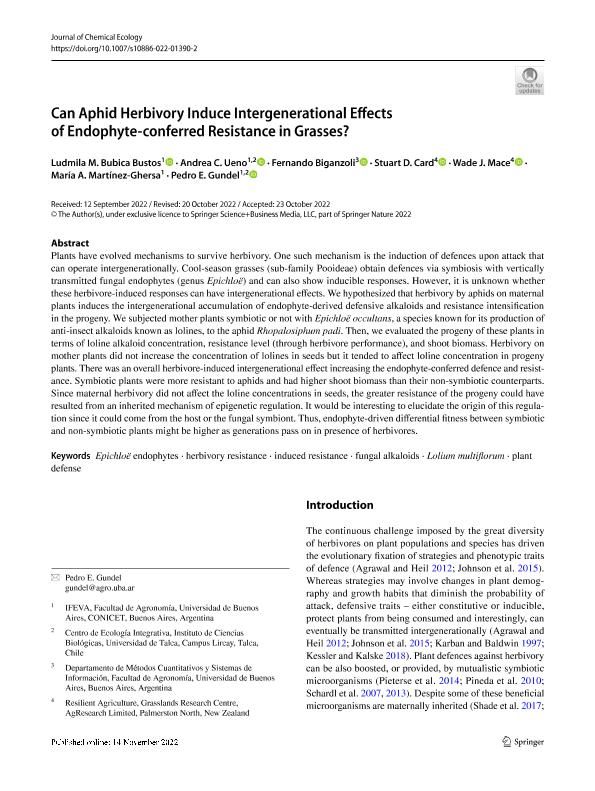Mostrar el registro sencillo del ítem
dc.contributor.author
Bubica Bustos, Ludmila Micaela

dc.contributor.author
Ueno, Andrea Celeste

dc.contributor.author
Biganzoli, Fernando

dc.contributor.author
Card, Stuart D.
dc.contributor.author
Mace, Wade J.
dc.contributor.author
Martínez Ghersa, María A.
dc.contributor.author
Gundel, Pedro Emilio

dc.date.available
2023-11-10T14:11:55Z
dc.date.issued
2022-12
dc.identifier.citation
Bubica Bustos, Ludmila Micaela; Ueno, Andrea Celeste; Biganzoli, Fernando; Card, Stuart D.; Mace, Wade J.; et al.; Can Aphid Herbivory Induce Intergenerational Effects of Endophyte-conferred Resistance in Grasses?; Springer; Journal of Chemical Ecology; 48; 11-12; 12-2022; 867-881
dc.identifier.issn
0098-0331
dc.identifier.uri
http://hdl.handle.net/11336/217737
dc.description.abstract
Plants have evolved mechanisms to survive herbivory. One such mechanism is the induction of defences upon attack that can operate intergenerationally. Cool-season grasses (sub-family Pooideae) obtain defences via symbiosis with vertically transmitted fungal endophytes (genus Epichloë) and can also show inducible responses. However, it is unknown whether these herbivore-induced responses can have intergenerational effects. We hypothesized that herbivory by aphids on maternal plants induces the intergenerational accumulation of endophyte-derived defensive alkaloids and resistance intensification in the progeny. We subjected mother plants symbiotic or not with Epichloë occultans, a species known for its production of anti-insect alkaloids known as lolines, to the aphid Rhopalosiphum padi. Then, we evaluated the progeny of these plants in terms of loline alkaloid concentration, resistance level (through herbivore performance), and shoot biomass. Herbivory on mother plants did not increase the concentration of lolines in seeds but it tended to affect loline concentration in progeny plants. There was an overall herbivore-induced intergenerational effect increasing the endophyte-conferred defence and resistance. Symbiotic plants were more resistant to aphids and had higher shoot biomass than their non-symbiotic counterparts. Since maternal herbivory did not affect the loline concentrations in seeds, the greater resistance of the progeny could have resulted from an inherited mechanism of epigenetic regulation. It would be interesting to elucidate the origin of this regulation since it could come from the host or the fungal symbiont. Thus, endophyte-driven differential fitness between symbiotic and non-symbiotic plants might be higher as generations pass on in presence of herbivores.
dc.format
application/pdf
dc.language.iso
eng
dc.publisher
Springer

dc.rights
info:eu-repo/semantics/openAccess
dc.rights.uri
https://creativecommons.org/licenses/by-nc-sa/2.5/ar/
dc.subject
EPICHLOË ENDOPHYTES
dc.subject
FUNGAL ALKALOIDS
dc.subject
HERBIVORY RESISTANCE
dc.subject
INDUCED RESISTANCE
dc.subject
LOLIUM MULTIFLORUM
dc.subject
PLANT DEFENSE
dc.subject.classification
Ecología

dc.subject.classification
Ciencias Biológicas

dc.subject.classification
CIENCIAS NATURALES Y EXACTAS

dc.title
Can Aphid Herbivory Induce Intergenerational Effects of Endophyte-conferred Resistance in Grasses?
dc.type
info:eu-repo/semantics/article
dc.type
info:ar-repo/semantics/artículo
dc.type
info:eu-repo/semantics/publishedVersion
dc.date.updated
2023-11-09T13:46:29Z
dc.journal.volume
48
dc.journal.number
11-12
dc.journal.pagination
867-881
dc.journal.pais
Alemania

dc.description.fil
Fil: Bubica Bustos, Ludmila Micaela. Consejo Nacional de Investigaciones Científicas y Técnicas. Oficina de Coordinación Administrativa Parque Centenario. Instituto de Investigaciones Fisiológicas y Ecológicas Vinculadas a la Agricultura. Universidad de Buenos Aires. Facultad de Agronomía. Instituto de Investigaciones Fisiológicas y Ecológicas Vinculadas a la Agricultura; Argentina
dc.description.fil
Fil: Ueno, Andrea Celeste. Consejo Nacional de Investigaciones Científicas y Técnicas. Oficina de Coordinación Administrativa Parque Centenario. Instituto de Investigaciones Fisiológicas y Ecológicas Vinculadas a la Agricultura. Universidad de Buenos Aires. Facultad de Agronomía. Instituto de Investigaciones Fisiológicas y Ecológicas Vinculadas a la Agricultura; Argentina
dc.description.fil
Fil: Biganzoli, Fernando. Universidad de Talca; Chile
dc.description.fil
Fil: Card, Stuart D.. Universidad de Buenos Aires. Facultad de Agronomía. Departamento de Métodos Cuantitativos y Sistemas de Información; Argentina
dc.description.fil
Fil: Mace, Wade J.. No especifíca;
dc.description.fil
Fil: Martínez Ghersa, María A.. No especifíca;
dc.description.fil
Fil: Gundel, Pedro Emilio. Consejo Nacional de Investigaciones Científicas y Técnicas. Oficina de Coordinación Administrativa Parque Centenario. Instituto de Investigaciones Fisiológicas y Ecológicas Vinculadas a la Agricultura. Universidad de Buenos Aires. Facultad de Agronomía. Instituto de Investigaciones Fisiológicas y Ecológicas Vinculadas a la Agricultura; Argentina
dc.journal.title
Journal of Chemical Ecology

dc.relation.alternativeid
info:eu-repo/semantics/altIdentifier/url/https://link.springer.com/article/10.1007/s10886-022-01390-2
dc.relation.alternativeid
info:eu-repo/semantics/altIdentifier/doi/http://dx.doi.org/10.1007/s10886-022-01390-2
Archivos asociados
